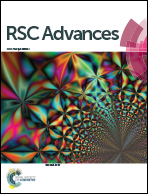Multilevel storage and photoinduced-reset memory by an inorganic perovskite quantum-dot/polystyrene floating-gate organic transistor†
Abstract
Inorganic halide perovskite quantum dots (IHP QDs) have been widely studied in optoelectronic devices because of their size-dependent tunable bandgaps, long electron–hole diffusion lengths and excellent absorption properties. Herein, a novel floating-gate organic field-effect transistor memory (FGOFETM) is demonstrated, comprising a floating-gate of IHP QDs embedded in a polystyrene matrix. Notably, the FGOFETM exhibits photoinduced-reset characteristic that allows data removal by photo irradiation. This feature makes low energy-consuming memory and innovative devices possible. The nonvolatile devices also show a large memory window (≈90 V), ultrahigh memory on/off ratio (over 107) and therefore excellent multilevel information storage, in which 4 recognizable non-volatile states and long retention time (up to 10 years) are obtained. This work not only offers an effective guideline of high-performance FGOFETMs, but also shows great potential to realize multilevel data storage under electrical programming and photoinduced-reset processes.



 Please wait while we load your content...
Please wait while we load your content...